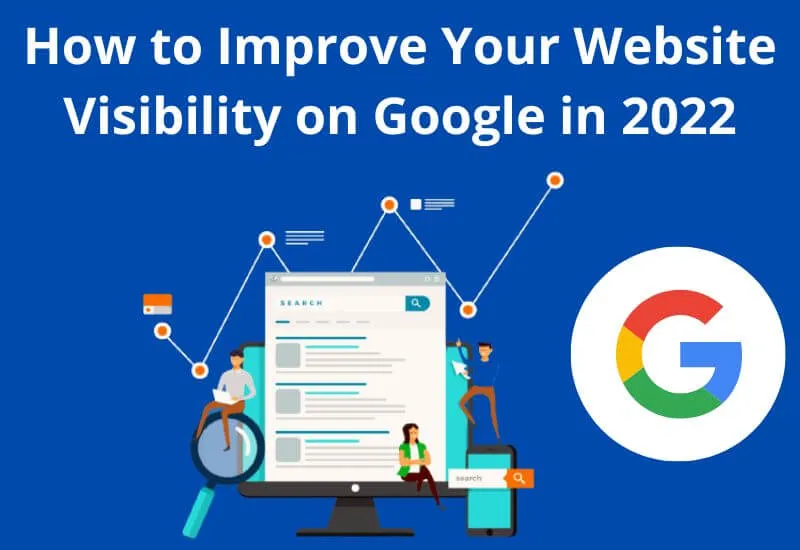How to Improve Your Website Visibility on Google – For today’s online business, having a website visible on Google actually means the difference between success and stagnation. The top ten in search engines is a treasured place where every entrepreneur strives to be, no matter what he does.
Recommendations for improving the visibility of sites in the Google search engine are constantly being improved: we offer simple and affordable SEO optimization measures
To improve website visibility in 2023, we suggest focusing on proper optimization, taking into account the latest trends and fundamental SEO rules. Below you will find a few points that you should pay priority attention to.
All optimization activities are divided into on page SEO (actions inside the site) and off page SEO (actions outside the site, such as link building).
In the first case, the results are noticeable much faster, so in our article we will discuss the main elements, the change of which can bring the most tangible results to the business.
Table of Contents
How to Improve Your Website Visibility on Google in 2023
Title meta tag: correct page title
Headings are one of the most important factors that affect page visibility. Page titles should be no longer than 60 characters (approximately 600 pixels) in the font used in Google’s SERPs. Slightly exceeding this limit will not affect the positioning results – only the quality of the page presentation will suffer due to the truncation of the title and replacing it with three dots.
Most CMS, including 1C-Bitrix, allow you to edit this tag yourself in standard functions. Some systems open this possibility after installing the appropriate plug-ins. For example, if the site is based on WordPress, Yoast SEO is the most suitable title management plugin.
What to consider when optimizing a meta title
keyword . The title has a huge influence on positioning, so it needs to be carefully thought out, placing the most important keywords for a particular URL. Ideally, the keywords should be included in the title unchanged.
Word order . To promote a site, it is important that the keywords are in the correct order. For example, for the phrase: “Summer sports shoes”, the heading “Summer sports shoes” will be much more profitable than “Sports shoes for summer”.
Separation of important phrases . As with keyword order, you shouldn’t separate the most important phrases with other words. Using the previous example, the heading “Summer sports shoes” would be more profitable than “Summer German sports shoes”.
Uniqueness . The last thing to keep in mind when optimizing a meta title is its uniqueness. If you use the same or a very similar title on another page, this can lead to problems in determining the relevance of the results to the selected query. The Google search engine checks for duplicate content on the site!
Meta Description: parameter (not) relevant to Google
Page descriptions do not have much effect on the position of pages, but they do have some effect on whether a user clicks on a link.
Meta description should, first of all, stand out among others and encourage the user to visit the site. To do this, it is advisable for you to analyze the meta descriptions of competitors in the search results and try to generate content that will be more interesting.
The meta description is used by the search engine as a summary of the most important information about a given page. Description optimization doesn’t matter when it comes to website visibility, but it will have a huge impact on click through rates.
What you need to know when creating a meta description?
Length . The ideal description length should be 160 characters. Exceeding this limit will not have a negative impact on site optimization, and long text will simply be truncated in search results.
Briefly about the main thing . The meta description should contain key information about the page, such as price, promotion information, etc. The purpose of this information is to increase the CTR. You can also moderately use emoticons that are appropriate for the context, additionally attracting the attention of visitors.
Keyword presence . If the key is present in the description, but will appear in bold in search results. This increases the likelihood that the user will go to this particular web page.
Headlines: The Biggest Difference for Google
Header, or header (h1, h2, h3…) are elements that describe the content of each subpage. There are 6 heading classes to choose from, but use them as needed.
Google gives the most importance to the h1 and h2 headings, so when creating your structure, you should include keywords in these two.
Each subpage should have a unique h1 title containing the most important keywords assigned to that address. The h2 heading should be an extended form of h1, including the keywords. The bottom headings are subheadings.
In practice, copywriters rarely need all the headlines, so don’t force them. The most important thing to remember is that the h1, h2, and h3 headings are in the correct order (h3 should be related to h2, offering more information related to h1).
This allows the search engine to accurately interpret the content contained in the page structure.
What to look for when optimizing headlines?
Availability of keywords . Headings should be written primarily for the user. However, we must not forget about placing the most important keywords in the headlines.
It is better to do this very carefully so that the title does not turn into a list of keywords that is devoid of meaning and interest for users. Therefore, it is necessary to find a compromise between naturalness and what will positively affect the visibility of the site.
Internal links: the basis for proper site indexing
Internal links are very important from an SEO standpoint, much like getting links from reputable external sources. The primary function of internal links on a page is to improve navigation for users as they navigate the site.
Through internal links, we can direct the reader to places on the website where they can learn even more about a topic of interest to them.
Thanks to this, we can easily influence the quality of behavioral data. Through good link management, we also extend the user’s interaction time with the website.
Places to Consider Internal Linking
Main menu . When creating a main menu, it will be more beneficial to use a text menu than a graphical (banner) menu. Remember to use keys with the highest priority.
Side menu . Additional space on the site where it is desirable to include internal linking. This is a quick and easy way to improve your internal link structure and make navigation easier for users.
Page descriptions . The content on each page is one of the most important places for internal links – both in category descriptions and in blog articles. Internal links in the content must be visible.
You can highlight them in a different color, additionally highlighting them so that the user does not have problems with recognition and switching to another subpage for additional information / offer.
Footer . This is where users look for more information about the site. It is worth placing here internal links leading to the most important and useful information pages of your site.
Content in accordance with the Content is King principle
The content on your site is the main element to work on. Service descriptions, as well as the main text on the home page, need to be polished to perfection, setting up optimization for selected keywords.
Naturally, you do not need to repeat keywords many times. First of all, the content should be user-friendly, and only secondarily is it optimized for effective website promotion in search engines.
Read Also: 40 SEO Mistakes that are easy to avoid
Currently, content uniqueness is not enough. Smart search engines evaluate hundreds of additional factors such as credibility, relevance, structure, user experience, and user response (time on page).
What to look for when creating and optimizing content?
Unchanged keywords . It is recommended that the main keyword be included in the content at least once, unchanged. For example, “improve site visibility in Google” instead of “how to increase visibility in Google”. Don’t overdo it as this can backfire.
Use of keywords in modified forms . When using keywords in subsequent repetitions, it is recommended to change them by case or in the plural / singular, depending on the original version. It is enough to adhere to the rule of writing for the user, and not for the search algorithm.
Use of synonyms . In addition to cases, Google allows the use of synonyms, which it also assigns to the main phrases on the site. As a result, the content sounds natural, does not contain repetitive words, and is pleasant for people.
Read Also: 5 Tips to Rank Higher on Google
Moderate number of keywords . When keyword-rich content, remember to keep it natural. Too many keywords in a short piece of text can negatively affect the naturalness and perception of the content by the user. The search engines do not welcome this either.
Correlation Based Optimization . When creating descriptions, it is worth analyzing competitor descriptions in organic results. Pay attention to parameters such as text length, number of paragraphs and heading structure, multimedia content, number of internal links, and the like.
Brief conclusion
The points listed above will help improve the visibility of the site in 2023, taking into account modern requirements, the most important in terms of SEO. However, according to official information from Google, there are more than 150 such factors.
These are the simplest steps in website optimization that you should start with and do not require special skills. Of course, they cannot guarantee getting into the TOP 3 for the most competitive keywords, but they will definitely improve your website traffic.

Lokesh Sharma is a digital marketer and SEO expert at TechJustify with a keen interest in emerging technology trends including AI, cybersecurity, and digital marketing tools for more than 5 years. He writes clear, actionable articles for tech enthusiasts and business leaders, simplifying complex topics like VPNs, automation, and generative AI.




